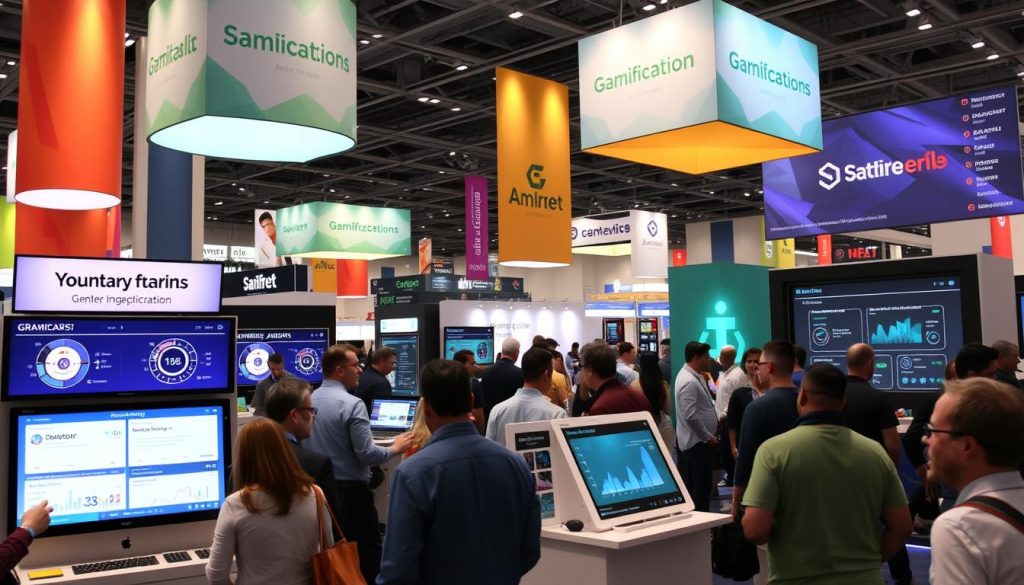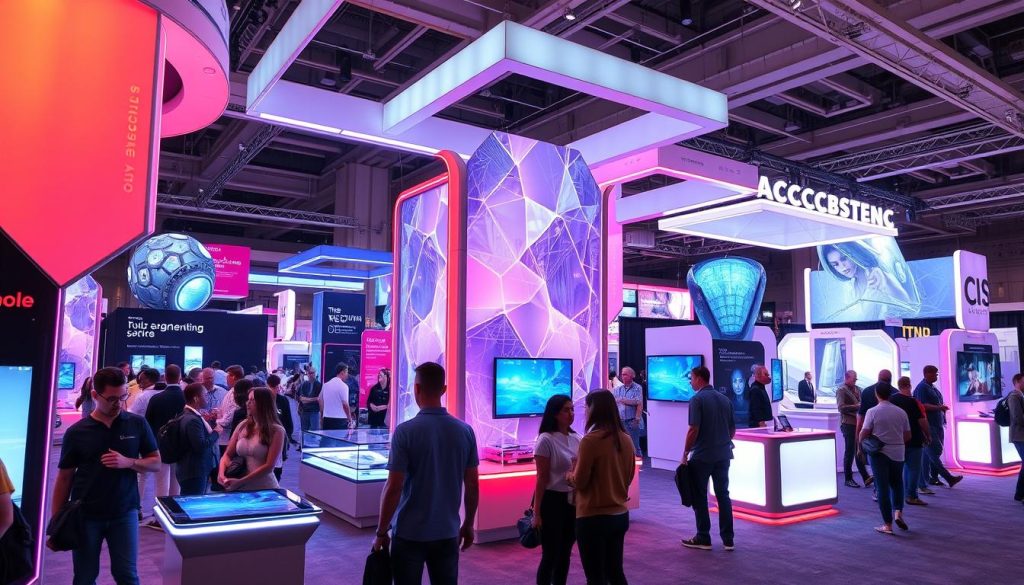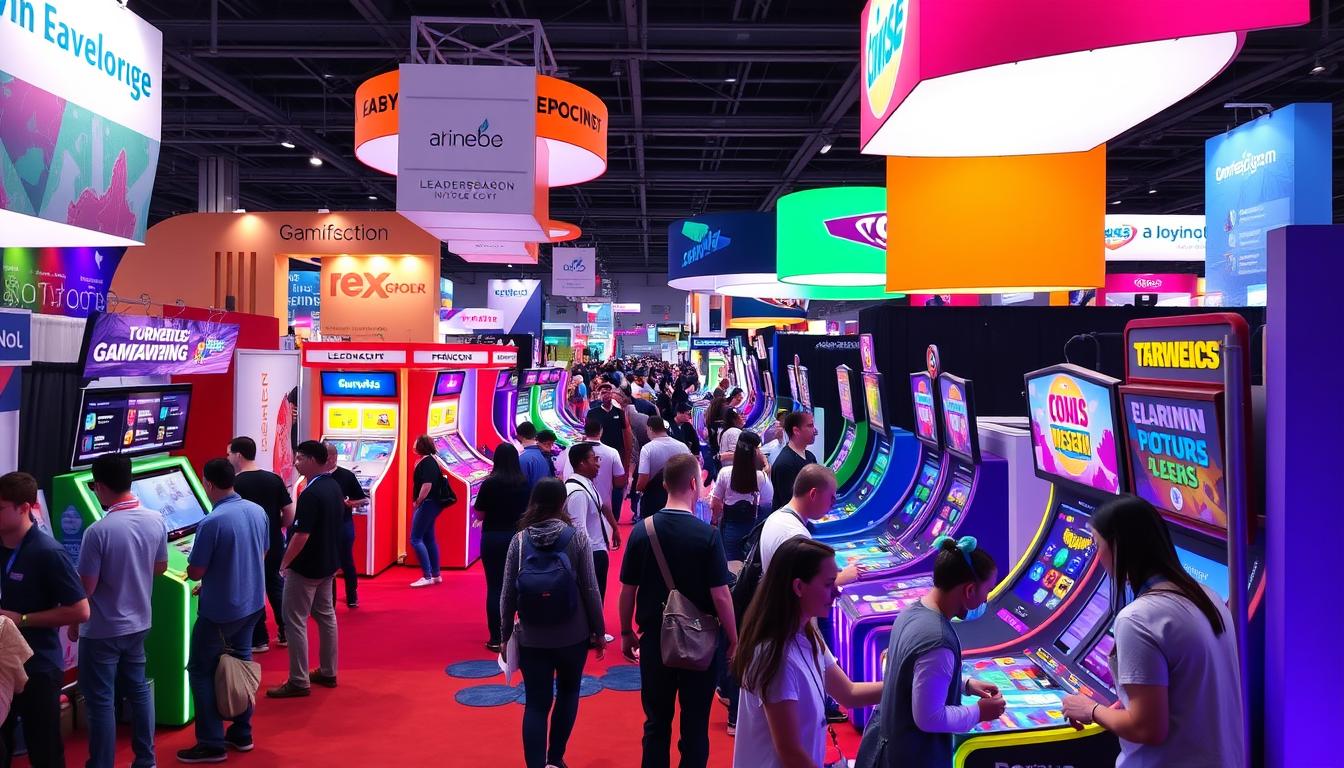Tradeshows are evolving, and gamification is at the forefront of this change. The science behind gamification at tradeshows is reshaping how businesses connect with attendees. By tapping into gamification psychology, companies are creating engaging experiences that leave lasting impressions.
Tradeshow engagement strategies now lean heavily on interactive elements. These fun, game-like features do more than entertain – they drive meaningful interactions. Attendees are more likely to remember brands that offer unique, playful experiences.
The power of gamification lies in its ability to spark curiosity and reward participation. When done right, it turns passive observers into active participants. This shift is crucial in today’s fast-paced tradeshow environment where attention is a precious commodity.
Key Takeaways
- Gamification enhances tradeshow engagement
- Interactive elements boost brand memorability
- Game-like features drive meaningful interactions
- Gamification turns observers into participants
- Psychology plays a key role in effective gamification
Understanding the Fundamentals of Gamification Psychology
Gamification psychology taps into our innate desire for achievement and reward. By applying game-like elements to non-game contexts, we can boost engagement and motivation in various settings, including tradeshows and events.
Core Drive Mechanisms in Human Behavior
Our brains are wired to seek pleasure and avoid pain. This simple principle underlies the core drive mechanisms in gamification. At events, tasks that offer immediate feedback or progress tracking can trigger these drives, keeping attendees engaged and excited.
Reward Systems and Dopamine Response
Rewards in gamified experiences stimulate dopamine release, creating feelings of pleasure and satisfaction. This neurochemical response reinforces behaviors, encouraging participants to continue engaging with the gamified elements of an event.
Intrinsic vs. Extrinsic Motivation Factors
Effective gamification balances intrinsic and extrinsic motivators. While prizes (extrinsic) can draw initial interest, the sense of mastery or achievement (intrinsic) often proves more powerful in sustaining long-term engagement. Understanding this balance is crucial when applying behavioral economics in events.
“Gamification isn’t about turning everything into a game. It’s about understanding human psychology and leveraging it to create meaningful experiences.”
By grasping these fundamentals of gamification psychology, event organizers can craft experiences that resonate deeply with attendees, tapping into the neuroscience of motivation to drive participation and satisfaction. The integration of these principles with event strategies can lead to memorable and impactful outcomes.
The Science Behind Gamification at Tradeshows
Gamification at tradeshows has revolutionized visitor engagement. This approach taps into human psychology to create memorable experiences. The science behind it reveals why interactive tradeshow experiences are so effective.
At its core, gamification leverages our brain’s reward system. When visitors participate in games or challenges, their brains release dopamine. This feel-good chemical reinforces positive behaviors and encourages continued engagement. Advanced analytics help track these interactions, providing valuable insights for exhibitors.
Tradeshow visitor retention techniques often rely on the principle of variable rewards. This concept, borrowed from psychology, keeps participants engaged by offering unpredictable outcomes. It’s why people keep playing slot machines or checking social media.
“Gamification in tradeshows isn’t just fun and games. It’s a strategic tool based on solid psychological principles.”
The science of gamification also taps into our innate desire for achievement. Leaderboards, badges, and progress bars all appeal to this drive. They create a sense of accomplishment, motivating visitors to complete tasks and engage more deeply with exhibitors.
Social proof, another key element, plays a significant role in tradeshow gamification. When visitors see others participating, they’re more likely to join in. This phenomenon, known as social facilitation, can significantly boost engagement levels across the event.
Neuroscience and Behavioral Economics in Event Engagement
The intersection of neuroscience and behavioral economics offers valuable insights into tradeshow engagement strategies. By understanding brain chemistry and decision-making patterns, event organizers can create powerful interactive experiences that captivate attendees.
Brain Chemistry During Interactive Experiences
When attendees participate in gamified activities at tradeshows, their brains release dopamine, a neurotransmitter associated with pleasure and reward. This neuroscience of motivation drives engagement and encourages repeat participation.
Decision-Making Patterns in Gaming Environments
Gaming environments at tradeshows tap into cognitive biases that influence decision-making. The scarcity principle, for example, creates a sense of urgency when limited-time offers are presented, prompting quicker actions from attendees.
Social Proof and Competitive Dynamics
Behavioral economics in events highlights the power of social proof. When attendees see others participating in games or challenges, they’re more likely to join in. Leaderboards and public achievements fuel competitive dynamics, driving increased engagement.
| Engagement Factor | Neuroscience Impact | Behavioral Economics Effect |
|---|---|---|
| Interactive Games | Dopamine Release | Increased Participation |
| Time-Limited Offers | Stress Response | Urgency-Driven Decisions |
| Leaderboards | Reward Anticipation | Competitive Behavior |
By leveraging these principles, event organizers can craft compelling tradeshow engagement strategies that resonate with attendees on a neurological level, fostering deeper connections and memorable experiences.
Designing Effective Gamification Strategies for Events
Crafting engaging tradeshow experiences requires a blend of creativity and strategy. Effective tradeshow engagement strategies leverage gamification to captivate attendees and create memorable interactions. By incorporating game elements, exhibitors can transform their booths into dynamic spaces that encourage participation and foster brand connections.
User experience design for exhibitions plays a crucial role in successful gamification. It’s essential to create intuitive interfaces that guide visitors through interactive challenges seamlessly. This approach not only enhances engagement but also boosts lead generation and data collection opportunities.
When designing interactive tradeshow experiences, consider these key elements:
- Clear objectives and rewards
- Personalized interactions
- Social sharing components
- Real-time feedback mechanisms
Implementing these features can significantly increase booth traffic and extend engagement beyond the event itself. Let’s explore how different gamification elements impact visitor behavior:
| Gamification Element | Visitor Impact | Brand Benefit |
|---|---|---|
| Points System | Encourages repeated interactions | Increased time at booth |
| Leaderboards | Sparks competitive spirit | Higher engagement rates |
| Achievement Badges | Provides sense of accomplishment | Enhanced brand recall |
| Timed Challenges | Creates urgency and excitement | Concentrated booth activity |
By thoughtfully integrating these elements, exhibitors can create immersive experiences that resonate with attendees long after the event concludes. The key is to balance entertainment with educational value, ensuring that every interaction serves a strategic purpose in building brand awareness and fostering customer relationships.
Interactive Technologies and User Experience Design
Innovative technologies shape user experience design for exhibitions, transforming tradeshow interactions. The fusion of digital tools with physical spaces creates engaging environments that captivate attendees and boost brand recall.
Mobile Integration Solutions
Mobile apps enhance interactive tradeshow experiences by offering personalized schedules, real-time updates, and networking features. These tools keep attendees connected and engaged throughout the event, increasing participation and data collection opportunities.
Augmented Reality Applications
AR technology brings exhibits to life, allowing visitors to interact with virtual product demonstrations or explore 3D models. This immersive approach elevates customer engagement and leaves lasting impressions on potential clients.
Real-time Analytics and Feedback Systems
Advanced analytics platforms provide instant insights into attendee behavior and preferences. These systems enable exhibitors to adapt their strategies on the fly, optimizing the user experience and boosting conversion rates.
Tradeshow gamification case studies reveal the power of these technologies in action. Let’s examine how different interactive elements contribute to successful exhibitions:
| Technology | Engagement Boost | Data Collection | ROI Impact |
|---|---|---|---|
| Mobile Apps | 35% increase | High | 25% improvement |
| AR Experiences | 50% increase | Medium | 40% improvement |
| Real-time Analytics | 20% increase | Very High | 30% improvement |
By leveraging these technologies, exhibitors can create memorable experiences that drive engagement and boost customer connections. The key lies in seamlessly integrating these tools to enhance the overall user experience at tradeshows.
Measuring Success: Analytics and Engagement Metrics
Evaluating the impact of tradeshow gamification case studies is crucial for refining future strategies. Let’s explore key metrics and methods to gauge the effectiveness of your tradeshow engagement strategies.
Key Performance Indicators
Successful tradeshow visitor retention techniques rely on tracking specific KPIs. These may include booth visit duration, participation rates in gamified activities, and lead quality scores. By monitoring these metrics, you can optimize your engagement strategies for maximum impact.
Data Collection Methods
Gathering accurate data is essential for assessing tradeshow gamification success. Consider these approaches:
- Digital check-ins at game stations
- Post-event surveys
- Social media engagement tracking
- Lead scanning technology integration

ROI Assessment Frameworks
Measuring the return on investment for tradeshow gamification requires a comprehensive framework. This might include comparing leads generated through gamified vs. non-gamified approaches, analyzing post-event sales conversions, and calculating the cost per engagement. By establishing clear ROI metrics, you can justify and refine your tradeshow engagement strategies for future events.
“Effective measurement is the cornerstone of successful tradeshow gamification. Without it, we’re just guessing.”
Remember, the goal is to create a data-driven approach that continually improves your tradeshow visitor retention techniques and overall event performance.
Case Studies: Successful Tradeshow Gamification
Tradeshow gamification case studies reveal the power of interactive experiences in boosting engagement. Let’s explore real-world examples that showcase effective tradeshow engagement strategies.
The tech giant IBM implemented a virtual reality game at their booth during a major industry event. Attendees donned VR headsets to navigate a 3D world, solving puzzles related to IBM’s products. This immersive experience led to a 30% increase in booth traffic and a 25% rise in lead generation compared to previous years.
Another standout example comes from the healthcare sector. Medical device manufacturer Medtronic created a mobile app-based scavenger hunt. Participants explored the tradeshow floor, scanning QR codes to learn about different products and earn points. This interactive tradeshow experience resulted in a 40% boost in booth visits and significantly higher engagement rates.
| Company | Gamification Strategy | Results |
|---|---|---|
| IBM | VR Puzzle Game | 30% increase in booth traffic, 25% rise in leads |
| Medtronic | Mobile Scavenger Hunt | 40% increase in booth visits, higher engagement |
| Nike | Interactive Product Customization | 50% increase in product interest, 35% more sales |
These case studies highlight the effectiveness of well-designed tradeshow gamification strategies in capturing attendee interest and driving meaningful interactions. By incorporating elements of competition, exploration, and personalization, companies can create memorable experiences that resonate with their target audience.
Implementation Challenges and Solutions
Implementing effective tradeshow engagement strategies can be challenging. Let’s explore key hurdles and practical solutions for creating interactive tradeshow experiences that captivate attendees.
Technical Infrastructure Requirements
Reliable technology is crucial for interactive tradeshow experiences. High-speed internet, robust Wi-Fi, and power supply are must-haves. Consider backup systems to prevent downtime. Partnering with tech providers can ensure smooth operation of digital displays and mobile apps.

Budget Considerations
Balancing costs with engagement goals is key. Prioritize elements that align with your objectives. Start small and scale up based on success. Explore cost-effective options like renting equipment or using modular designs that can be reused at future events.
| Item | Cost Range | Impact on Engagement |
|---|---|---|
| Interactive Kiosks | $2,000 – $5,000 | High |
| Mobile App Development | $5,000 – $20,000 | Medium to High |
| VR/AR Experiences | $10,000 – $50,000 | Very High |
Staff Training Needs
Equip your team with the skills to manage interactive elements. Conduct pre-event training sessions on new technologies and engagement techniques. Create quick reference guides for troubleshooting common issues. Remember, well-trained staff enhances user experience design for exhibitions.
“Investing in staff training is investing in the success of your interactive tradeshow experience.”
By addressing these challenges, you’ll be better prepared to create memorable and effective tradeshow engagement strategies that resonate with attendees and drive results.
Conclusion
The science behind gamification at tradeshows opens up a world of exciting possibilities for event organizers. By tapping into core psychological drives and reward systems, companies can create interactive tradeshow experiences that leave lasting impressions. Understanding how our brains respond to gaming elements allows for the design of engaging activities that boost participation and memory retention.
Effective tradeshow engagement strategies now go beyond traditional booth setups. They leverage mobile tech, augmented reality, and real-time analytics to craft immersive environments. These tools not only captivate attendees but also provide valuable data on user behavior and preferences. This insight helps refine future approaches and measure return on investment.
As we’ve seen, successful implementation of gamification at tradeshows requires careful planning. From technical infrastructure to staff training, every aspect plays a crucial role. By embracing these innovative techniques, businesses can transform their tradeshow presence. The result? More meaningful connections, increased brand awareness, and ultimately, a competitive edge in the bustling world of trade events.
FAQ
What is gamification in the context of tradeshows?
Gamification at tradeshows refers to the application of game-design elements and game principles in non-game contexts to enhance attendee engagement, motivation, and participation. It involves creating interactive experiences that tap into human psychology to make tradeshow interactions more enjoyable and memorable.
How does gamification psychology work in tradeshow settings?
Gamification psychology in tradeshows works by leveraging core drive mechanisms in human behavior, such as achievement, social influence, and unpredictability. It utilizes reward systems that trigger dopamine responses, balancing intrinsic and extrinsic motivation factors to create engaging experiences that resonate with attendees.
What are some examples of interactive tradeshow experiences?
Interactive tradeshow experiences can include digital scavenger hunts, virtual reality product demonstrations, touchscreen quizzes, social media challenges, leaderboard competitions, and augmented reality booth tours. These experiences are designed to increase engagement, information retention, and brand recall.
How does neuroscience contribute to effective gamification strategies?
Neuroscience contributes to gamification by helping us understand brain chemistry during interactive experiences. It provides insights into decision-making patterns in gaming environments and explains how social proof and competitive dynamics affect behavior. This knowledge allows for the creation of more effective and engaging gamification strategies.
What are some key considerations in user experience design for exhibitions?
Key considerations in user experience design for exhibitions include intuitive interfaces, clear instructions, seamless technology integration, personalization options, and accessibility. It’s crucial to design experiences that are easy to understand, enjoyable to interact with, and align with the overall goals of the tradeshow and exhibitors.
How can tradeshow visitor retention be improved through gamification?
Tradeshow visitor retention can be improved through gamification by creating compelling reasons for attendees to stay engaged throughout the event. This can be achieved through progressive challenges, time-released content, multi-day competitions, and personalized experiences that evolve based on attendee interactions and preferences.
What role do mobile integration solutions play in tradeshow gamification?
Mobile integration solutions play a crucial role in tradeshow gamification by providing a personal, accessible platform for attendees to interact with gamified elements. They enable features like QR code scanning, real-time notifications, personalized schedules, and social sharing, enhancing the overall interactive experience and data collection capabilities.
How can the success of gamification strategies at tradeshows be measured?
The success of gamification strategies can be measured through various metrics, including engagement rates, time spent at booths, lead quality and quantity, social media mentions, and post-event surveys. Advanced analytics tools can track user interactions, provide real-time feedback, and help calculate the ROI of gamification initiatives.
What are some common challenges in implementing gamification at tradeshows?
Common challenges include technical infrastructure requirements, budget constraints, staff training needs, and ensuring the gamification aligns with business objectives. Additionally, creating a balance between entertainment and information delivery, as well as designing experiences that appeal to diverse attendee demographics, can be challenging.
How does behavioral economics influence event engagement through gamification?
Behavioral economics influences event engagement by helping designers understand and leverage cognitive biases and decision-making patterns. This knowledge is used to create gamified experiences that nudge attendees towards desired behaviors, such as visiting specific booths, attending presentations, or sharing information on social media.


